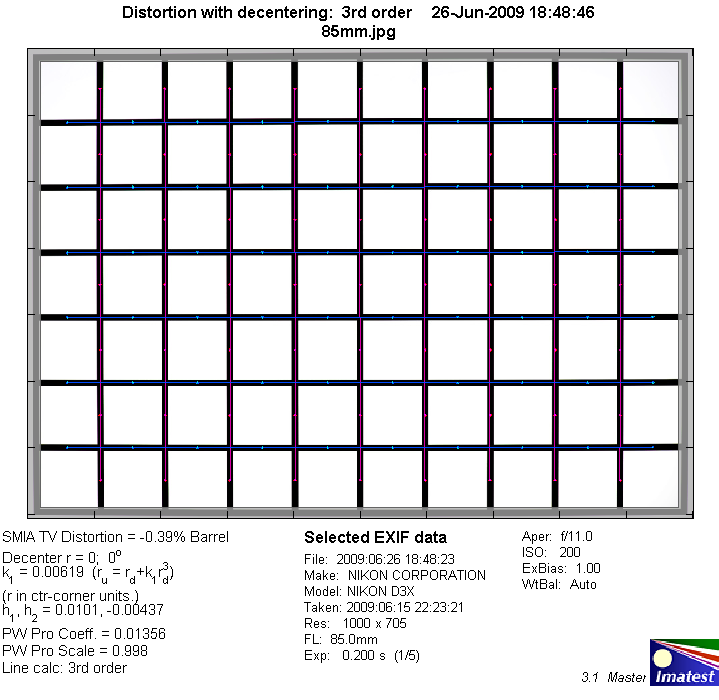|
Page 2 of 3

Distortion
Typical for many short tele primes, the lens shows very moderate barrel type distortion just short of 0.4 %. So for most photographic applications the lens can be considered free of noticeable distortion.

The chart above has a real-world size of about 120x80cm.
Vignetting
Fast lenses tend to suffer from high vignetting on full frame cameras and the AF-D 85/1.4 is no exception to this rule. With below 1.5 EV wide open the amount of vignetting is of course clearly visible in the final image, however it's still a bit lower than expected from such a fast lens. There's a moderate level of vignetting left at f/2.0 which is reduced further to an almost negligible degree stopped down to f/2.8 and beyond.
We're performing our vignetting analysis based on
(uncorrected) JPEGs straight from the camera. The JPG engine of the Nikon D3x features a rather flat
gradation curve, thus has a moderate contrast characteristic, resulting in comparatively low vignetting figures - the
corresponding Canon figures are roughly 40% higher due to the more
aggressive default contrast setting.

MTF (resolution)
The AF-D 85/1.4 produced mixed results in our lab tests. The center resolution is very good wide open already, increasing to excellent figures by f/2.8.
The borders and corners however show a different behaviour, starting of very soft wide open. The lens needs to be stopped down quite a bit to reach good and (just) very good sharpenss in these areas.
The lens showed some focus shift when stopping down (residual spherical aberration).
Please note that the MTF results are not directly comparable across the different systems!
Below is a simplified summary of the formal findings. The chart shows line widths
per picture height (LW/PH) which can be taken as a measure for sharpness.
If you want to know more about the MTF50 figures you may check out the corresponding
Imatest Explanations

Chromatic Aberrations (CAs)
Chromatic aberrations (color shadows at harsh contrast transitions) are in the range of roughly 0.8 to 1.4 pixels throughout the aperture range. This might be visible in very large prints (or heavy crops), however, for typical print sizes the problem isn't really field relevant for most subjects. In addition, CAs can easily be corrected in software or by the camera itself.

Bokeh
For portraiture, the quality of the bokeh (out-of-focus blur) is of course a primary aspect, and especially in this lens class it's usually one of the reasons to choose one of the high end and ultra fast offerings over the slightly slower (but usually stil faster than required) f/1.8 siblings. The AF-D 85/1.4 delivers high quality in this regard, with smooth backgrounds right from its fastest aperture setting. There is a slight tendency towards some nervousness in the transition zone, but otherwise the background as well as foreground bokeh is very pleasing.
Thanks to 9 rounded aperture blades, background highlights remain their circular shape throughout the whole aperture range, except towards the edges of the frame, where highlights show a cat's eye shape (which is typical behaviour for fast glass, however). Highlights are evenly filled, there is almost no outlining, but some traces of LoCAs (which, again, are typical for this lens glass, see next section).

Bokeh Fringing / Longitudinal Chromatic Aberrations (LoCA)
LoCAs (non-coinciding focal planes of the various colors) are a common issue with relatively fast glass. As you can
notice below the halos have different colors - magenta (red + blue) in front the focus point
and green beyond. Truly "apochromatic" lenses don't show LoCAs but these lenses are very rare especially
below 100mm. Unlike lateral lateral CAs, LoCAs cannot easily be fixed in post processing.
Typical for most fast primes, especially ultra fast ones, the AF-D 85 shows a considerable amount of LoCAs at large aperture settings, which can of course be reduced by stopping down.
In addition, these shots also show the focus shift when stopping down.
|